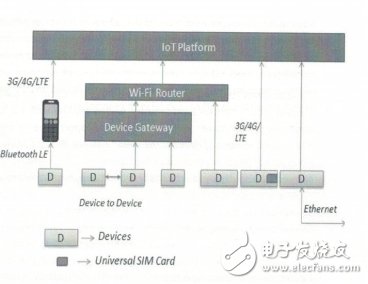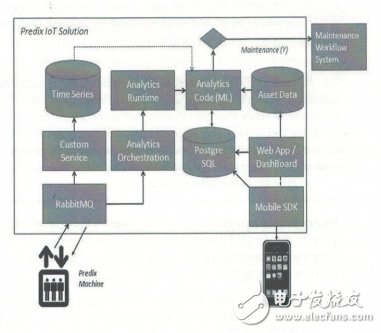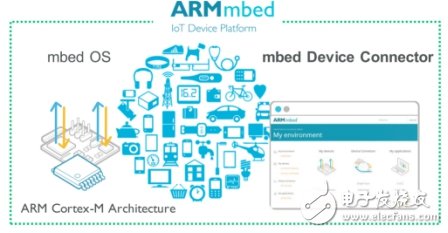Looking back on the past 2016, embedded technology and the Internet of Things are developing rapidly. Embedded technologies are exploring emerging markets based on the consolidation of traditional applications. The Internet of Things (IoT) is one of the most widely used application markets. In the new technological revolution driven by innovation, the Internet of Things will undoubtedly bring greater transformation and destructiveness to the industry. It enables us to connect the digital world with the physical world and create new services for companies to reach customers. Have a profound impact. 2017 has arrived, as the only professional exhibition in the embedded field in China - Shenzhen International Embedded Systems Exhibition, invited industry expert He Xiaoqing, on the embedded and Internet of Things technology will be a development trend, make a brief Analysis and conclusion.
First: M&A has a profound impact on the development of embedded processorsIn the past year and in the future, chip suppliers are still eager to cut costs and further increase profits through mergers and acquisitions. Chip vendors need to set aside enough profit on current products to fund next-generation product development, and as costs increase, they need to figure out how to increase returns. The mergers we have seen recently include Qualcomm and NXP, Microchip and Atmel, and Renesas and Intersil. These mergers take 1-2 years to integrate and digest, so in the short term, mergers and acquisitions will affect the development of embedded processor technology and market. However, in the long run, mergers and acquisitions will benefit the promotion and popularization of Internet of Things technologies and systems. Because IoT applications require processor designs to provide solutions for end users and applications, IoT applications require chip design that emphasizes power efficiency, security, ease of use of development tools, and cost reduction, all of which require chip vendors to develop Investing in the development of embedded processors (including microcontrollers) with better integration and better software support, I believe that in 2018, the industry can see more innovative embedded IoT chip solutions.
M&A will lead the embedded processor to the vertical market for IoT applications, and chip market leaders shift their focus to high-growth market opportunities such as automotive assisted driving (ADAS), autonomous driving, machine vision, artificial intelligence (AI) and 5G. For these vertical markets, leading chip suppliers have also adopted acquisition strategies. For example, Samsung recently acquired Harman to enter the automotive market, Intel acquired Movidius and entered the machine vision market. Movidius is a startup company, and machine vision chips have been applied in Dajiang. On the man-machine and Google Tango AR phones, it’s hot. Although these vertical market sizes are still small, there are great business opportunities in the future, chip companies are reluctant to give up these opportunities, and chips will continue in the vertical market.
The Internet of Things will focus on low cost, low power and power efficiency, and the performance of existing embedded processors and microcontrollers (MCUs) is sufficient for most IoT applications. Most embedded applications do not require the highest performance, they require the best power efficiency and lowest power consumption. Leading embedded processor vendors will continue to deliver the best integration and power efficiency for targeted applications with the right size chip products.
Microcontrollers (MCUs), which have been successfully mastered with 8-bit microcontrollers, have ushered in the wave of development of the Internet of Things after years of tempering. 32-bit microcontrollers will occupy an important layout in low-power and always-on IoT systems. The development of MCUs for the Internet of Things market will not decrease, the integration of microcontrollers will become higher and higher, and the software platform will be more The richer the processor, the closer the combination of sensors and sensors and the cloud will be.
Embedded processors and microcontrollers are core components of embedded and IoT systems, and ARM is currently the market leader. ARM processor core-based microcontrollers and processors dominate the vast majority of embedded and IoT markets. Share, With the rise of innovative technologies such as machine vision, virtual reality and artificial intelligence, the role and influence of GPUs is growing and cannot be underestimated. The popularity of the Internet of Things has led to the development of low-power computing and wireless networks. In the future, new processor technologies and business models will emerge in this field. Artificial intelligence (AI) will further improve computing, and embedded edge computing will optimize computing. The ability and real-time improvement play a huge role. Amazon's Alexa is an example. The Internet of Things and artificial intelligence will promote the development and application of new processor architectures. Open source hardware (including open source chips) will be a trend.
Second: the Internet of Things cloud platform enters maturityThere are three ways of cloud computing: software as a service (SaaS), platform as a service (PaaS) and infrastructure as a service (IaaS). The Internet of Things cloud platform is an application of cloud computing PaaS. The architecture of the Internet of Things cloud platform (IoT Platform) is shown in Figure 1. The Internet of Things (Device) communicates with the Device Gateway or smartphone via Bluetooth and Zigbee wireless communication links, and then connects to the IoT cloud platform via WiFi and 4G/LTE communication networks. Cloud IaaS's basic cloud service provides IoT devices with the ability to access and manage lifecycle services.

Figure 1 Internet of Things cloud platform
At present, the well-known foreign IoT cloud platform has Amazon AWS IoT.
Microsoft's Azure IoT, GE's PredixIoT (see Figure 2), IBM Watson IoT and PTC IoT (ThingsWork) platforms. The domestic IoT cloud platforms include China Mobile OneNet, Guangzhou Wisdom Cloud and Ali Smart Cloud. The open source IoT cloud platform has Kaa and Eclipekura projects.

Figure 2 General Electric's Predix IoT platform
Traditional enterprise software companies such as Oracle, SAP and Redhad are also developing IoT cloud platforms for enterprise applications. Their tentacles have entered the field of IoT sensors, also known as Enterprise IoT in foreign countries. The IoT market for enterprise applications is in the future 1- The two-year rapid development, such as enterprise connected cars, smart cities and smart industrial projects, traditional enterprise software companies will open the situation in 1-2 vertical markets by building an ecological environment, and then gradually expand the application field.
Third: the Internet of Things operating system has sprung upAs open source software matures, embedded systems have adopted a large number of open source software, such as the Linux operating system. In addition to the fast-paced development of security and reliability requirements in automotive electronics, aerospace and defense, traditional embedded operating systems are slow to grow and lack a profitable business model. With the development of the Internet of Things cloud platform, the operating system embedded in the device side is also being combined with the cloud platform to form a new Internet of Things operating system (also known as OperaTIng System for Internet of Things). The existing IoT operating systems include ARM mbed OS (see Figure 3), Google's Android Things, Microsoft's Windows 10 IoT Core, Huawei's LiteOS, and Genko's Mico OS.

Figure 3 ARM mbed OS application diagram
Although technology giants are pushing the Internet of Things operating system, open source software will be active for a long time in the future. Such as FreeRTOS (the smart watch originator Pebble and many IoT devices use FreeRTOS), TInyOS and so on. This is because the demand for the Internet of Things system is not clear, the business model is not mature, and the IoT operating system technology is developing, and it is still to be verified in the product. Some users will tend to choose open source software to customize the Internet of Things that suits them. operating system.
Fourth: IoT security has a long way to goOn October 21, 2016, the US had a large regular network including Amazon and Twitter. The reason was that the DNS service provider Dys was attacked by DDos. The Dys issued a statement that it might be 100,000 IoT devices infected with Miral malware. This puts the IoT security, which is widely watched, on the cusp. On October 26th, US security research team Shellphish performed the hacking of Huawei P9 lite mobile phone fingerprint unlocking function, and the security door event of a video surveillance equipment in Hangzhou in 2015. The security of IoT equipment has received more and more attention.
Previously, smart product manufacturers only considered protecting the functional safety of their devices and the security of the data they generated. Even with this requirement, many device manufacturers, especially consumer electronics, could not accomplish this task. Now they are being asked to help protect equipment and networks, not even the security of their own customers. What is more difficult is that IoT security design is still in the process of exploration, and there is no mature design and implementation method.
Another aspect of embedded system security is the functional safety of embedded devices (FuncTIonal safety), functional safety in industrial electronics (IIoT) related fields such as automotive electronics, factory automation, industrial instrumentation, rail transit signals, and smart grid. The demand is the most urgent, the design and implementation methods in this aspect are relatively standardized, and commercial companies also have mature software and tools to provide project consulting and services.
2017 will be a year in which embedded and IoT technologies will be developed. As the integration of chip companies after mergers and acquisitions is gradually completed, some IoT applications will come to fruition and form scale. In 2017, the narrowband Internet of Things (LPWAN) technology developed rapidly, and several standard chips, platforms and networks of LoRa, Sigfox and NB-IoT went hand in hand. China has just announced that it has built the world's largest 5G test field in Huairou, Beijing, providing an end-to-end test environment that will help promote the formation of 5G standards and industry development. One of the key technologies of the 5G standard IoT, 5G medium and low power large connection and low latency high reliability scene are mainly oriented to the Internet of Things business, which is the new direction of 5G new development.
In 2018, we will usher in a breakthrough development of embedded and IoT technology. The development and optimization of operating system technology and network security technology for IoT applications will become more and more mature. Processor technology will be driven by the rapid development of virtual reality and artificial intelligence. There will be a refreshing development under the support of a new generation of network technology, the development of the Internet of Things will usher in a new era of rapid development.
The 6th Shenzhen International Embedded Systems Exhibition EMBEDDED EXPO 2017 will be held on December 21-23, 2017 at the Shenzhen Convention and Exhibition Center. As the annual event in the embedded field in China, the Embedded Systems Show brings together professionals, buyers and decision makers from the embedded and application industries to provide components, modules, embedded boards, and intelligent systems for the entire industry chain. A one-stop communication platform with IoT solutions.
Highlights of the 2017 Embedded Systems Show include: cloud computing and IoT security, open source hardware and maker sports, and wireless technology development; embedded technology and IoT applications, industry 4.0, smart factories and industrial Internet of Things, car networking, and Popular industry application solutions include: intelligent buildings, smart cities, intelligent transportation, security, finance, and retail will also receive much attention. For more details, please visit the official website:
Extended reading:[1] For more information about the Internet of Things operating system, you can read the article “Finance Internet of Things Operating System†by Zhou Yuan, “Reporter of Finance and Economics†on January 23, 2017. This article is currently discussing the development of the Internet of Things operating system. A detailed article.
[2] For the Internet of Things operating system and open source embedded operating system technology and evolution history, you can refer to the author, Mechanical Industry Press, November 2016, "Embedded Operating System Fengyun Record: Historical Evolution and the Future of the Internet of Things" This book.
[3] For embedded system security, you can refer to David Kleidermacher's translation of Zhou Qingguo and others, Mechanical Industry Press, 2015, "Embedded System Security: A Practical Approach to Security and Trusted Software Development." This book is a very good book in the embedded system security book that is rarely seen at home and abroad.
[4] For enterprise IoT technology and market analysis, it is recommended to refer to Dirk Slama, Frank Puhlmann and other OREILLY published "Enterprise IoT: startegies & Best PracTIces for Connected Product & Service". The two main authors are from Bosch, Germany. Combined, the content is close to the current application scenario.
About the Author:He Xiaoqing is a well-known embedded system expert. He was one of the earliest involved in embedded OS in China. He founded Beijing Maxtech Software Technology Co., Ltd., with 30 years of embedded technology and market experience. He is also a director of the China Software Industry Association, vice chairman of the Embedded Systems Branch, and secretary general of the Embedded Systems Association. Published "Embedded Operating System Fengyun Record: Historical Evolution and the Future of the Internet of Things", embedded real-time operating system μC/OS-III application development and "embedded software refinement" and many other works and translations.
Shenzhen Xcool Vapor Technology Co.,Ltd , https://www.szxcoolvapor.com